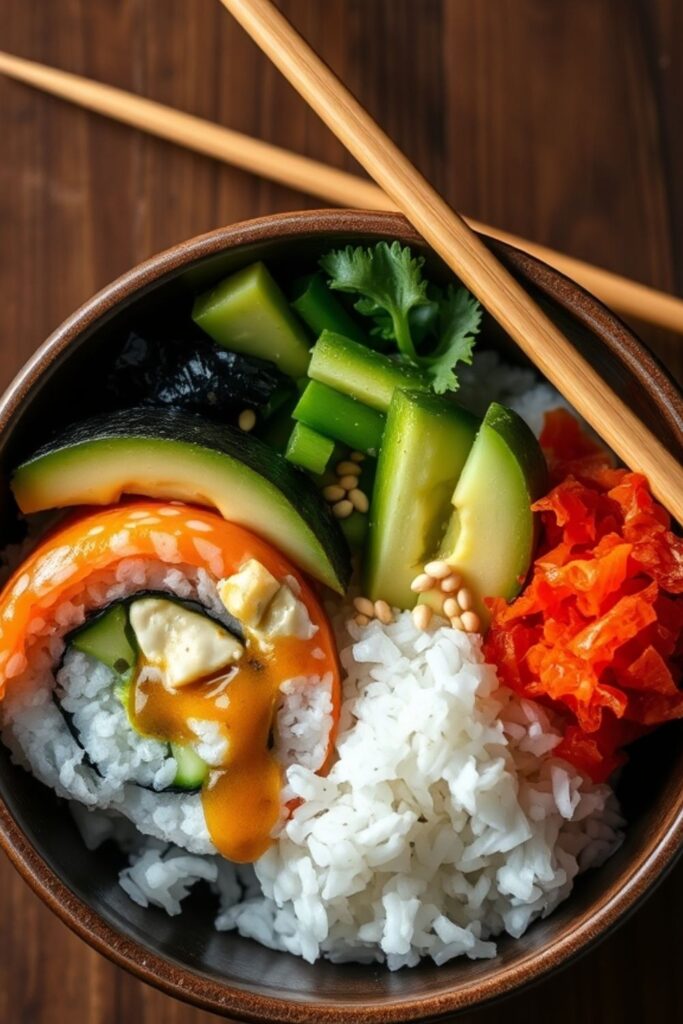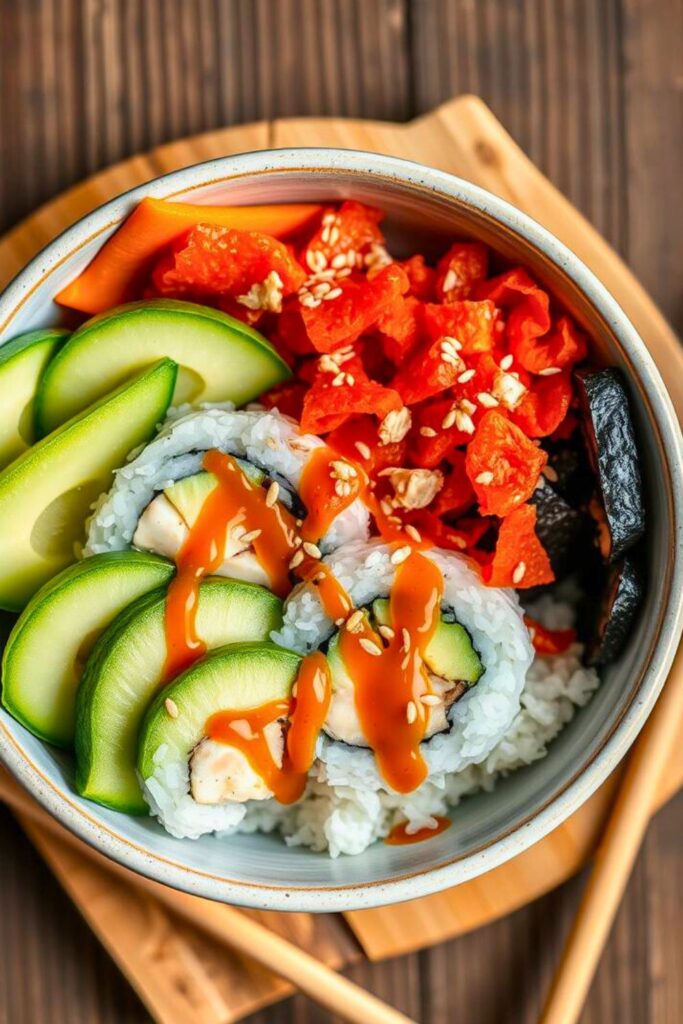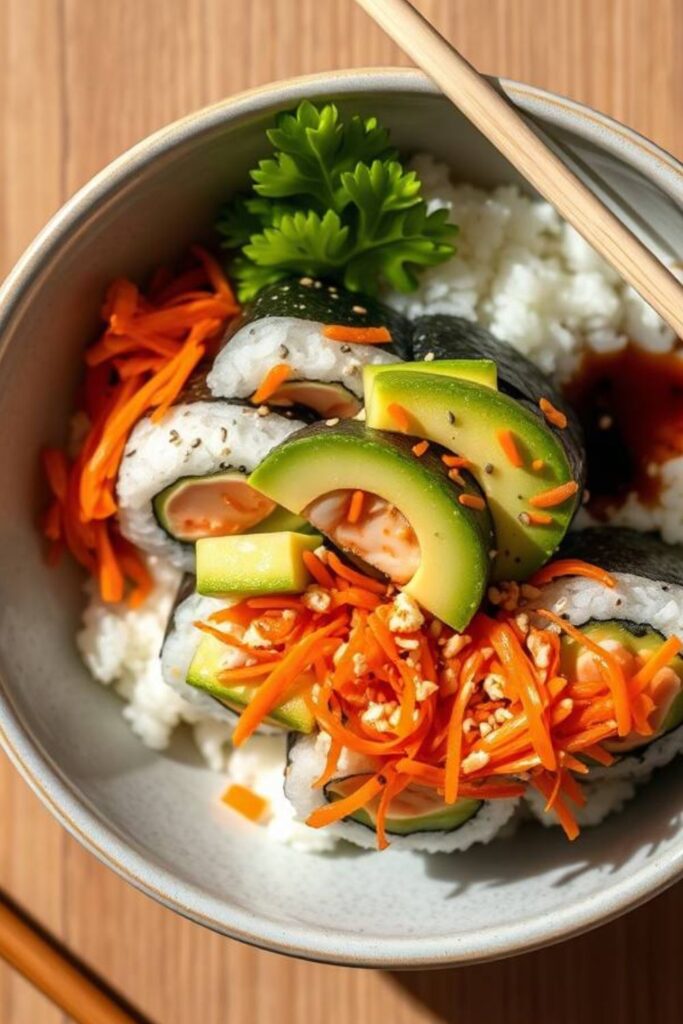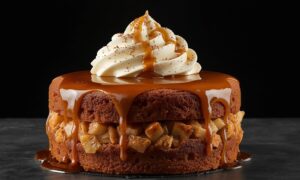You’ve had that day. Long, messy, and dinner is a mystery. The fridge is full, but nothing feels inspiring, and you’re craving something fresh, flavorful, and comforting. Maybe it’s a midweek slump or maybe you’re just done with the same old takeout. You want something fun, not fussy. Nostalgic, yet a little new. That’s exactly when my California Roll Sushi Bowls came to life.
It wasn’t planned. Just me, craving sushi, with zero energy to roll anything. I stared at half a ripe avocado, leftover sushi rice, and a pack of crab sticks I bought on impulse. The soy sauce bottle called out. The spicy mayo whispered its promise. And suddenly, I was layering rice, cucumber, nori, and tobiko in a bowl. Not a cookbook fix. Just pure comfort in the middle of kitchen chaos.
There’s something so satisfying about how creamy avocado melts into warm rice, how crisp cucumber contrasts the salty soy drizzle, and the spicy mayo ties it all together. Toasted sesame seeds add the perfect crunch, and once the chopsticks hit the bowl, it’s sushi night, simplified.
This bowl comes together fast, tastes incredible, and hits every sushi craving without the hassle. Whether it’s for family dinner or solo comfort food, it feels fresh, filling, and just fancy enough.
Stick with me through the next few steps, I’ll show you how to build this bowl, share creative twists, and give you shortcuts you’ll love. Trust me, once you taste it… you’ll make it on repeat.
Why These Bowls Will Change Your Dinner Game

Here’s what makes these bowls special: complete control over every element. Adjust rice texture exactly how you like it. Make spicy mayo as fiery or mild as you want. Choose real crab or quality imitation based on budget.
The beauty lies in the layering technique. Each component stays distinct yet harmonious. Every bite creates different flavor combinations. It’s like getting three amazing meals in one bowl.
Essential Ingredients for Perfect Sushi Bowls
Build your ingredient arsenal the smart way. I always prep these components in cooking order. This keeps workflow smooth and prevents frantic scrambling.
For the Sushi Rice Foundation:
- 2 cups short grain white rice (this is non negotiable)
- 3 cups water
- 1/3 cup rice vinegar
- 3 tablespoons sugar
- 1 teaspoon salt
The Star Players:
- 1 pound lump crab meat (or high quality imitation crab)
- 2 ripe avocados
- 1 large cucumber
- 4 sheets nori (seaweed), cut into strips
- 2 tablespoons sesame seeds (black and white for contrast)
The Magic Sauce:
- 1/2 cup Japanese mayonnaise
- 2 tablespoons sriracha (adjust to taste)
- 1 teaspoon sesame oil
- 1 tablespoon rice vinegar
Smart Ingredient Swaps That Actually Work
Can’t find short grain rice? Medium grain works but loses sticky texture. Long grain rice won’t cut it here, trust me.
Dairy sensitive? Swap mayo for mashed avocado mixed with tahini. Different but delicious in its own right.
Living somewhere without decent seafood? Cooked shrimp works beautifully. Try smoked salmon for a completely different but satisfying bowl.
Find nori sheets at Asian grocery stores or international aisles. No nori? Thinly sliced radishes add similar color and crunch.
Here’s an insider secret about picking avocados: they should yield slightly to pressure but not feel mushy. Too firm? Leave them on the counter for two days. Too ripe? They’ll still taste great but won’t hold shape.
Mastering the Sushi Rice Technique
This transforms good bowls into great bowls. Sushi rice isn’t just cooked rice, it’s seasoned, cooled, and treated with respect. The Japanese call it “shari” the foundation everything builds on.
Start by rinsing your rice until water runs clear. This removes excess starch and prevents gummy rice. Most people skip this step, but it’s crucial for perfect texture.
Cook rice using the absorption method. Bring water and rice to a boil, then reduce to the lowest simmer and cover. Cook exactly 18 minutes, then rest off heat for 10 minutes. No peeking, lifting the lid releases steam and affects texture.
While rice cooks, make your sushi vinegar. Heat vinegar, sugar, and salt just until sugar dissolves. Don’t boil, you’ll cook off delicate rice vinegar flavor.
Here’s the pro technique: transfer hot rice to a wide bowl and gradually fold in seasoned vinegar using cutting motions. Never stir in circles, that makes rice gummy. Fan the rice while mixing to cool quickly and create glossy finish.
Rice should taste slightly tangy and sweet, with individual grains that stick together but aren’t mushy. If it tastes too sharp, you added vinegar too quickly. Next time, add more gradually.
Building Your California Roll Sushi Bowl Like a Pro

Now comes the fun part, assembly. This isn’t just about dumping ingredients in a bowl. The order and technique matter if you want that restaurant presentation.
Start with a layer of warm (not hot) sushi rice in your serving bowls. Make a shallow well in the center, this creates visual interest and gives each topping its own space.
Prepare your cucumber first. I like to use a vegetable peeler to create long ribbons, but thin rounds work too. Salt them lightly and let them sit for 10 minutes, then pat dry. This draws out excess moisture and prevents soggy bowls.
For the crab, flake it gently and pick through for any shell pieces. If you’re using imitation crab, shred it with your fingers rather than chopping. The irregular pieces look more natural and interesting.
Cut your avocado just before serving to prevent browning. Here’s a restaurant trick: slice the avocado while it’s still in the skin, then scoop out perfect slices with a spoon.
Arrange everything in sections around your rice well. Think of it like a painter’s palette, each ingredient gets its own space but they all work together visually.
Drizzle your spicy mayo in a pattern that’s both functional and beautiful. I like to use a squeeze bottle for clean lines, but a spoon works fine too.
Common Mistakes That’ll Tank Your Bowl
Going too heavy on the sauce is mistake number one. These bowls should celebrate the ingredients, not drown them. Start light; you can always add more.
Don’t make the rice too hot when you serve it. Warm is perfect, but hot rice will wilt your avocado and make everything soggy.
Cutting the avocado too early is another rookie move. Brown avocado ruins the visual appeal, even though it tastes fine.
The Science Behind Perfect Sushi Rice
Understanding what happens when you make sushi rice transforms you from someone following directions to someone who truly gets it. The magic starts with the rice variety. Short grain rice has more amylopectin than long grain varieties. That’s the starch that creates the sticky, clingy texture essential for sushi.
When you rinse the rice, you’re removing surface starch that would otherwise make your rice gluey rather than properly sticky. There’s a difference, good sushi rice grains stick together but maintain their individual integrity.
The seasoning process is where chemistry meets culinary art. Rice vinegar is milder than other vinegars, with a subtle sweetness that complements rather than competes with delicate seafood flavors. The sugar balances the acidity, while salt enhances all the other flavors.
Temperature matters enormously here. Hot rice absorbs the seasoning too quickly, leading to mushy texture. Rice that’s too cool won’t absorb the flavors properly. Room temperature rice, that’s the sweet spot.
The fanning technique serves multiple purposes. It cools the rice quickly, preventing overcooking from residual heat. It also evaporates excess moisture, concentrating flavors and improving texture. Professional sushi chefs use special wooden fans, but a regular fan or even a piece of cardboard works fine.
Tools That Make the Difference
A rice cooker eliminates guesswork and produces consistent results every time. But don’t think you need fancy equipment, a heavy bottomed pot with a tight fitting lid works perfectly.
A wooden spoon or rice paddle prevents scratching your bowl and won’t conduct heat like metal utensils. Plus, wood doesn’t react with the acid in the rice vinegar.
Wide, shallow bowls are better for cooling and seasoning rice than deep ones. The increased surface area helps moisture evaporate more efficiently.
Making It Beautiful and Instagram Worthy

Presentation isn’t just about looking good, it’s about creating an experience that makes people excited to eat. Color contrast is your secret weapon here. The white rice provides a neutral canvas, while the green avocado, orange crab, and black nori create visual drama.
Height adds interest to your bowl. Don’t flatten everything down. Let some ingredients pile naturally, creating shadows and depth.
Garnishing with sesame seeds isn’t just traditional, it’s smart. The nutty flavor complements the other ingredients, while the small size and contrasting colors add textural and visual interest.
For photography, natural light is your friend. Position your bowl near a window and use a simple background that won’t compete with your food.
Consider your serving bowls carefully. White or neutral colors show off the ingredients best. Dark bowls can work too, but they’ll make your photos moodier and less vibrant.
Perfect Pairings That Complete the Meal
These bowls pair beautifully with light, crisp wines. A dry riesling or sauvignon blanc complements the seafood without overwhelming the delicate flavors. If you prefer beer, try a wheat beer or light lager.
For non alcoholic options, green tea is traditional and perfect. The subtle bitterness balances the rich mayo and creamy avocado. Sparkling water with a splash of yuzu or lime also works wonderfully.
Side dishes should be simple and complementary. Miso soup adds warmth and umami depth. Pickled vegetables provide acidic contrast that cleanses the palate between bites.
Variations That Keep Things Interesting
Once you’ve mastered the basic technique, the variations are endless. Try substituting cooked shrimp for crab, or go luxurious with real crab meat from fresh caught Dungeness or blue crabs.
Vegetarian? Replace the seafood with marinated tofu or tempeh. The key is adding enough umami rich elements, think mushrooms, miso, or seaweed salad.
Spice lovers can amp up the heat by adding fresh jalapeños or increasing the sriracha in the mayo. Just remember that heat should enhance, not mask, the other flavors.
For a tropical twist, add diced mango or pineapple. The sweetness plays beautifully against the savory elements, especially if you include some fresh mint or cilantro.
Brown rice works if you want more fiber and nutrition, though the texture will be different. The nutty flavor actually complements the sesame and nori nicely.
Troubleshooting When Things Go Wrong
Rice too sticky? You probably didn’t rinse it enough before cooking, or added the seasoning too quickly while it was too hot. Next time, rinse until the water runs clear and let the rice cool to room temperature.
Avocado turning brown? Lemon or lime juice helps, but the best solution is cutting it just before serving. If you must prep ahead, store cut avocado in the fridge with plastic wrap pressed directly against the surface.
Mayo too spicy or not spicy enough? Start with less sriracha than you think you need, you can always add more, but you can’t take it back. If you’ve overdone it, add more mayo and a touch of rice vinegar to balance things out.
Flavors tasting flat? Salt is probably your answer. A tiny pinch can brighten everything up. Also check that your rice seasoning has enough vinegar, underseasoned rice makes the whole bowl taste bland.
Why California Roll Sushi Bowls Belong in Your Weekly Rotation
California roll sushi bowls solve the eternal dinner dilemma: you want something special but don’t have hours to spend in the kitchen. They’re fancy enough for date night but simple enough for a Tuesday evening.
The make ahead potential is incredible. Rice can be made a day ahead and stored in the fridge. The spicy mayo keeps for a week. Even the cucumber can be prepped hours in advance if you salt it properly.
These bowls also scale beautifully. Making dinner for two? Easy. Feeding a crowd? Just multiply the ingredients and set up a DIY bowl station. People love customizing their own portions.
The nutrition profile is impressive too. You’re getting healthy fats from avocado, protein from seafood, and complex carbs from rice. It’s balanced without being boring.
Most importantly, these bowls taste like restaurant quality but cost a fraction of the price. You’re looking at maybe $8-10 for ingredients that would cost $25-30 at a decent sushi restaurant.
Remember, confidence in the kitchen comes from understanding your ingredients and techniques, not from following recipes blindly. Once you master these sushi bowls, you’ll find yourself improvising and creating your own variations naturally.
Start with this recipe exactly as written. Get comfortable with the techniques. Then let your creativity run wild. That’s when cooking stops being a chore and becomes pure joy.
California Roll Sushi Bowls: Questions & Answers
Can I make the rice ahead of time?
Absolutely! Sushi rice actually improves after sitting for a few hours. Store it covered at room temperature for up to 4 hours, or refrigerate for up to 3 days. Just bring it back to room temperature before serving, cold rice won’t absorb flavors as well and has a harder texture.
What’s the difference between real crab and imitation crab for this recipe?
Real crab has a more delicate, sweet flavor and firmer texture. It’s worth the extra cost for special occasions. Imitation crab (which is actually made from fish) has a milder taste and softer texture that some people actually prefer in sushi bowls. Both work great, choose based on your budget and taste preference.
How far ahead can I prep the other ingredients?
The spicy mayo keeps for up to a week in the fridge. Cucumber can be sliced and salted up to 4 hours ahead, just pat it dry before using. Avocado should be cut just before serving to prevent browning. Crab can be picked through and flaked a day ahead.
My rice turned out mushy, what went wrong?
This usually happens from too much water or not rinsing the rice enough before cooking. The ratio should be 1.5 cups water to 1 cup rice for short grain varieties. Also, make sure you’re not stirring the rice while it cooks, this breaks up the grains and creates a mushy texture.
Can I substitute brown rice or other grains?
You can, but the texture and flavor will be quite different. Brown rice has a nuttier taste and chewier texture that some people prefer. Quinoa or cauliflower rice work for low carb versions, though they won’t have that signature sushi rice stickiness. Whatever you choose, adjust the seasoning accordingly since different grains absorb flavors differently.

Swiftly Captions by Tina Smith — Quick, flavorful food recipes made simple, bringing fresh inspiration to your kitchen every day






